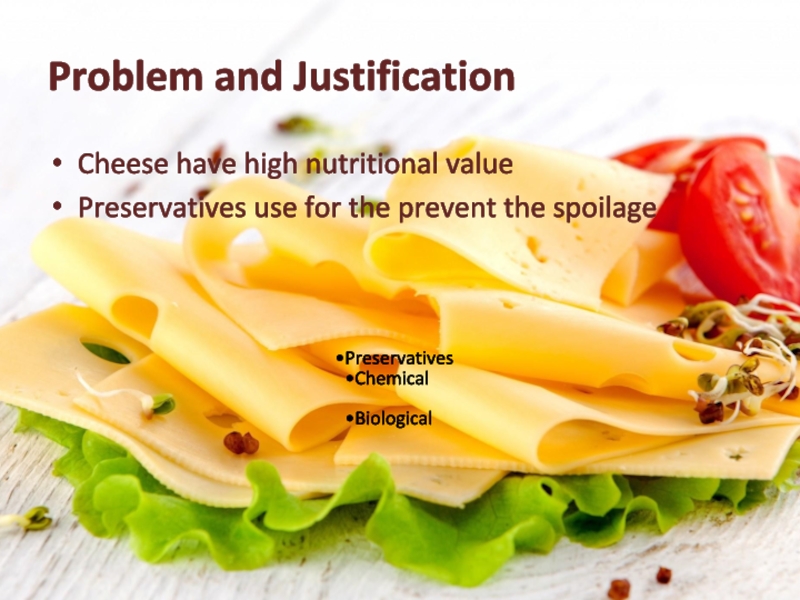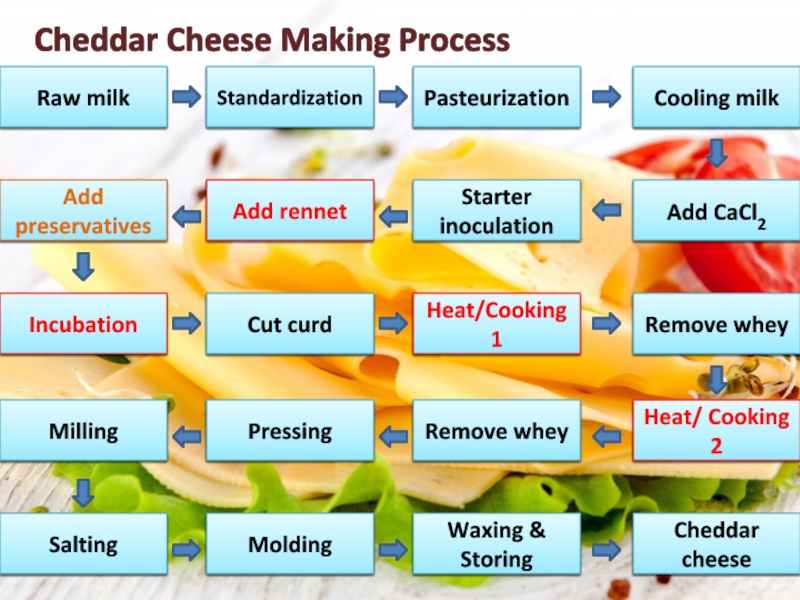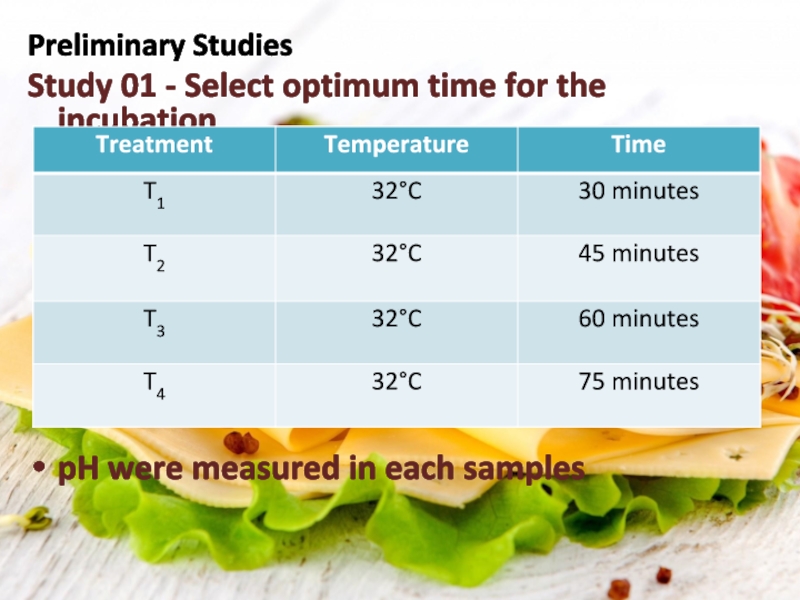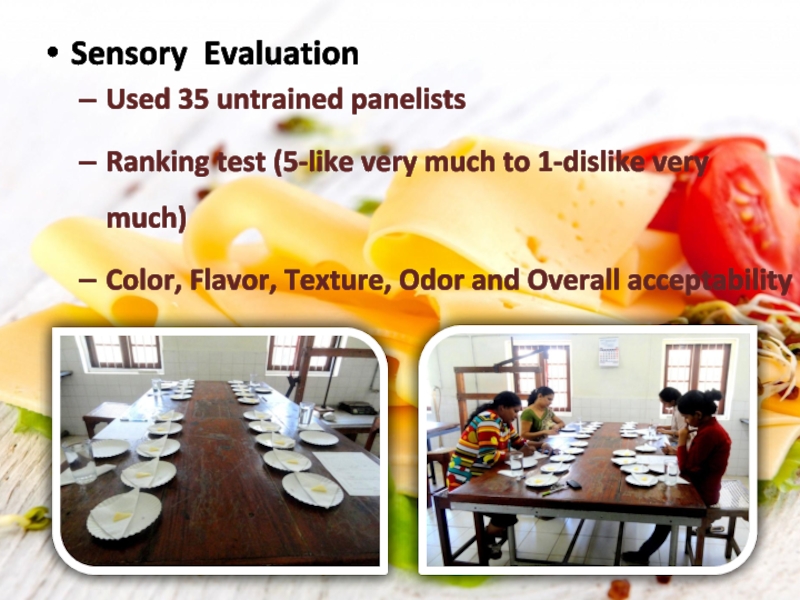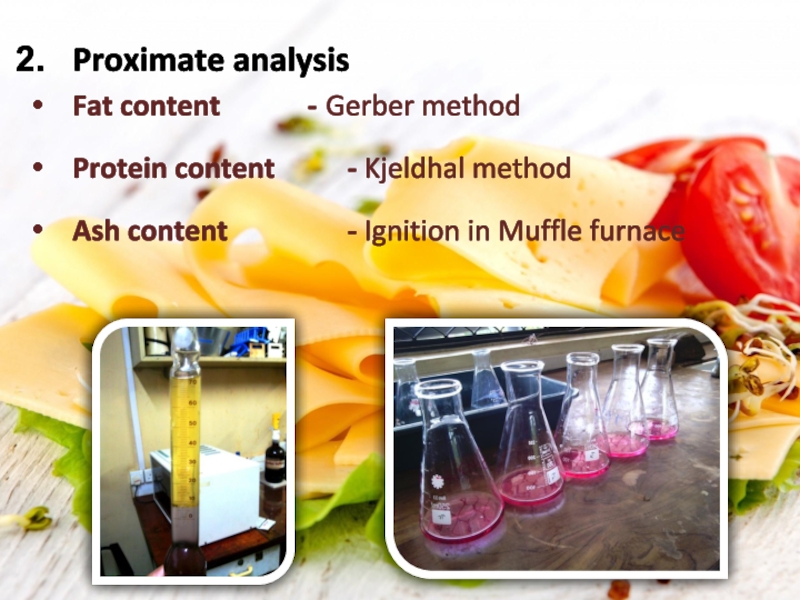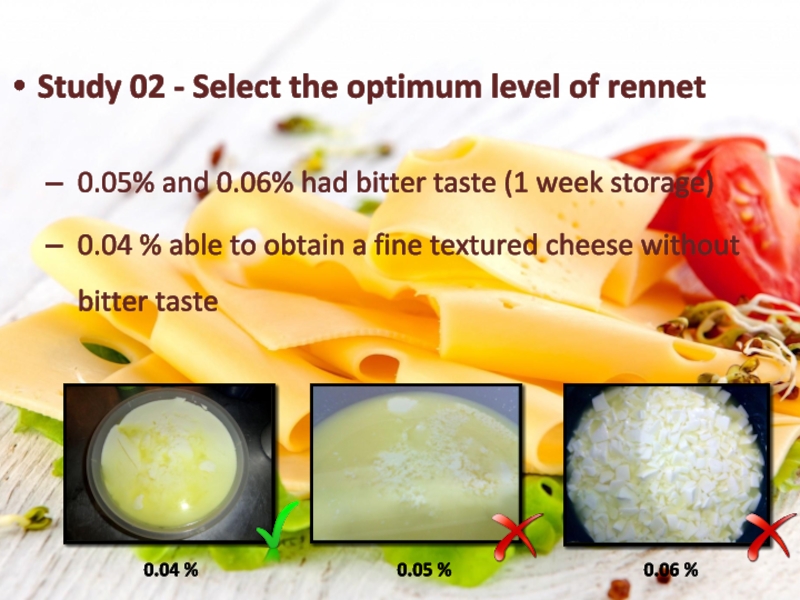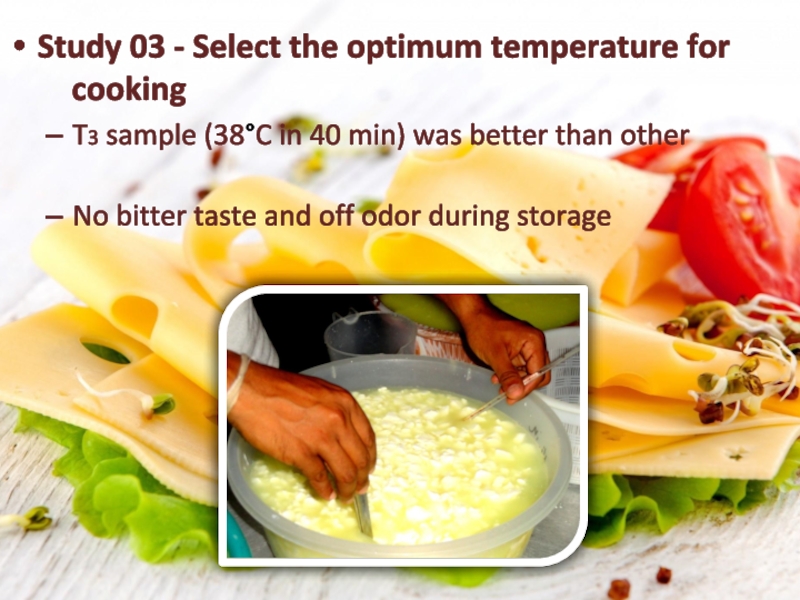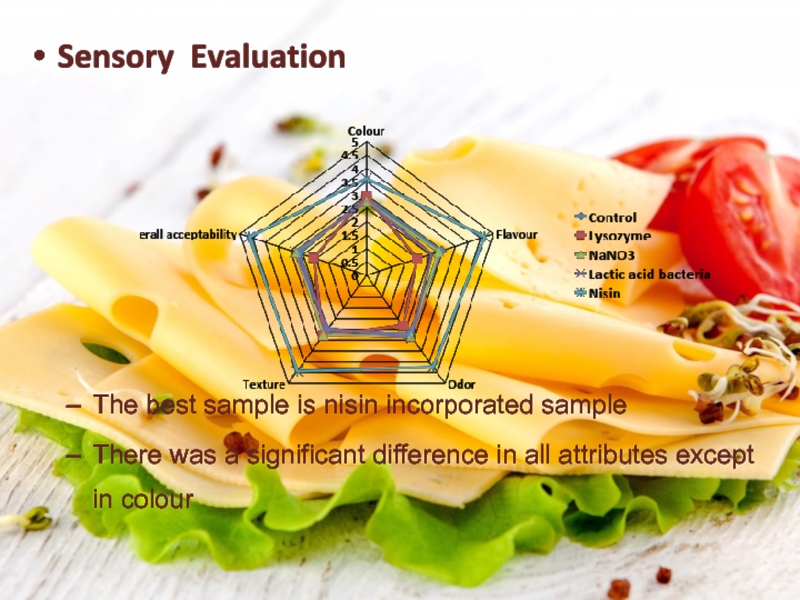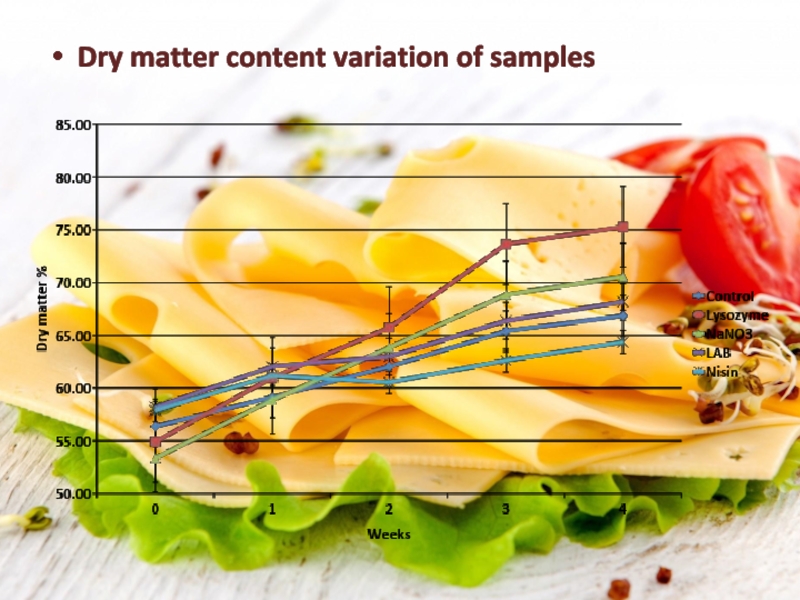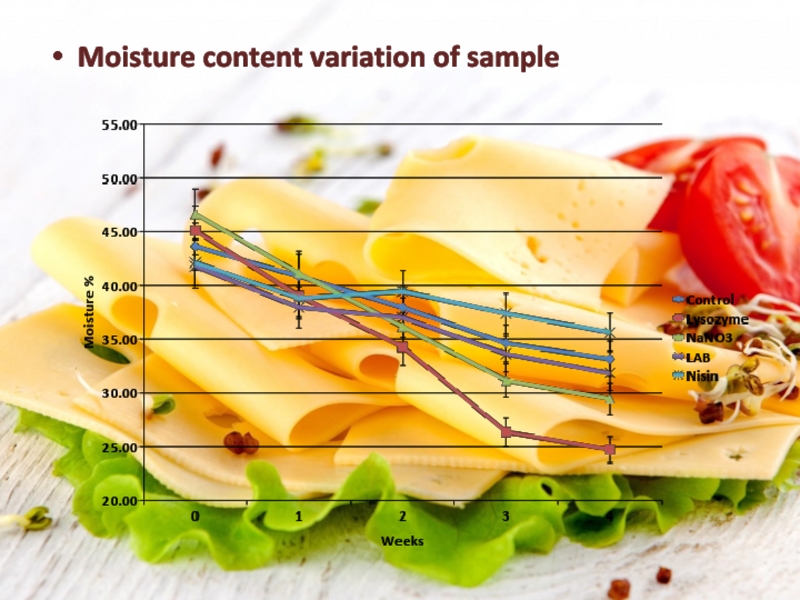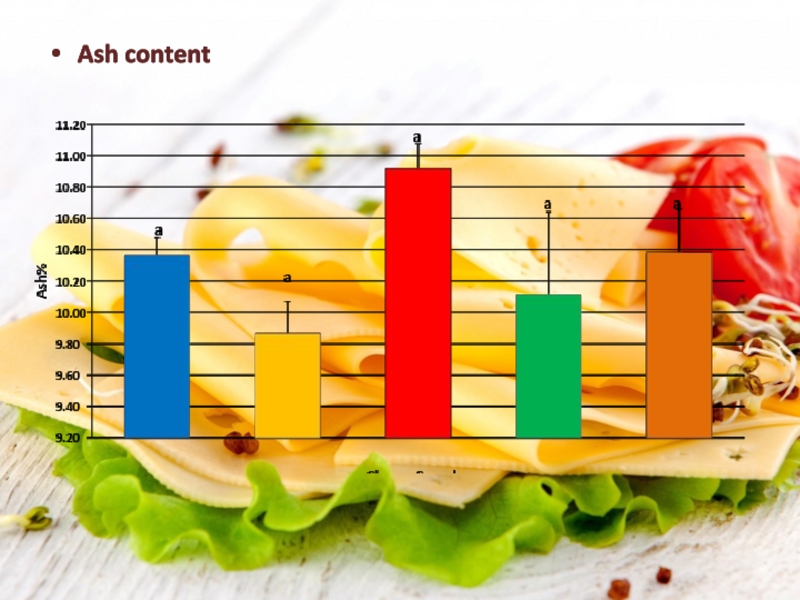C.P. Ulpathakumbura
AG/2008/2009/148
Department of Animal and Food Sciences
Faculty of Agriculture
Rajarata University of Sri Lanka
- Главная
- Разное
- Дизайн
- Бизнес и предпринимательство
- Аналитика
- Образование
- Развлечения
- Красота и здоровье
- Финансы
- Государство
- Путешествия
- Спорт
- Недвижимость
- Армия
- Графика
- Культурология
- Еда и кулинария
- Лингвистика
- Английский язык
- Астрономия
- Алгебра
- Биология
- География
- Детские презентации
- Информатика
- История
- Литература
- Маркетинг
- Математика
- Медицина
- Менеджмент
- Музыка
- МХК
- Немецкий язык
- ОБЖ
- Обществознание
- Окружающий мир
- Педагогика
- Русский язык
- Технология
- Физика
- Философия
- Химия
- Шаблоны, картинки для презентаций
- Экология
- Экономика
- Юриспруденция
Development of a Cheddar Cheese Using Biological Preservatives as Substitute for Chemical Preservatives презентация
Содержание
- 1. Development of a Cheddar Cheese Using Biological Preservatives as Substitute for Chemical Preservatives
- 2. Introduction Milk is the most natural and
- 3. Problem and Justification Cheese have high nutritional
- 4. By using chemical preservatives Can use biological preservatives
- 5. Nisin Lysozyme Lactic Acid Bacteria
- 6. Objectives General Objective Development of a Cheddar
- 7. Specific Objectives To evaluate sensory properties
- 8. Methodology Step 1 Preliminary studies Step
- 9. Raw milk Cooling milk Pasteurization Standardization Add
- 10. Preliminary Studies Study 01 - Select optimum
- 11. Study 02 - Select the optimum level
- 12. Study 03 - Select the optimum temperature
- 13. Selection of the best sample made by using different preservatives
- 14. Sensory Evaluation Used 35 untrained panelists Ranking
- 15. Analysis of Cheese Samples A. Physico-chemical
- 16. Physico-chemical Analysis Dry matter percentage (DM %)
- 17. Proximate analysis Fat content - Gerber method Protein
- 18. Microbial Analysis Yeast and Mold count -
- 19. Data Analysis Parametric data analysis ANOVA for
- 20. Study 01 - Select optimum time for
- 21. Study 02 - Select the optimum level
- 22. Study 03 - Select the optimum temperature
- 23. Sensory Evaluation
- 24. Physico-chemical Analysis Titratable acidity variation of samples
- 25. pH variation of samples
- 26. Texture variation of samples
- 27. Dry matter content variation of samples
- 28. Moisture content variation of sample
- 29. Proximate Analysis Fat content
- 30. Protein content
- 31. Ash content
- 32. Microbial Analysis Yeast and Mold count
- 33. Total lactic acid bacteria count
- 34. Conclusion Biological preservative can be used
- 35. Suggestions Use biological preservatives as a blend
- 36. Thank you
- 37. Cost Benefit Analysis 1l
Слайд 1Development of a Cheddar Cheese Using Biological Preservatives as Substitute for
Слайд 2Introduction
Milk is the most natural and nutritious, single food on the
Cows’ milk use for make several types of foods
Cheese is a preserved form of milk made by using live cultures to transform the milk through chemical process, and then by the coagulation
Слайд 3Problem and Justification
Cheese have high nutritional value
Preservatives use for the prevent
Preservatives
Chemical
Biological
Слайд 6Objectives
General Objective
Development of a Cheddar cheese using biological Preservatives as substitute
Preservatives
Слайд 7Specific Objectives
To evaluate sensory properties of the cheddar cheese
To assess the
To evaluate the physico-chemical properties of the cheddar cheese
Слайд 9Raw milk
Cooling milk
Pasteurization
Standardization
Add preservatives
Add CaCl2
Starter inoculation
Add rennet
Incubation
Remove whey
Heat/Cooking 1
Cut curd
Milling
Heat/ Cooking
Remove whey
Pressing
Salting
Cheddar cheese
Waxing & Storing
Molding
Cheddar Cheese Making Process
Слайд 10Preliminary Studies
Study 01 - Select optimum time for the incubation
pH were
Слайд 11Study 02 - Select the optimum level of Rennet
Flavor was checked
Слайд 12Study 03 - Select the optimum temperature for cooking
Flavor and
Слайд 14Sensory Evaluation
Used 35 untrained panelists
Ranking test (5-like very much to 1-dislike
Color, Flavor, Texture, Odor and Overall acceptability
Слайд 15Analysis of Cheese Samples
A. Physico-chemical analysis
B. Microbial analysis
C. Proximity analysis
D. Sensory
Week 0
Week 1
Week 2
Week 3
Week 4
A
B
A
B
A
B
D
A
B
A
B
C
Слайд 16Physico-chemical Analysis
Dry matter percentage (DM %) - Oven dry method
Moisture percentage
Texture - Instron machine
pH - pH meter
Titratable acidity - Titrating with NaOH
Слайд 17Proximate analysis
Fat content - Gerber method
Protein content - Kjeldhal method
Ash content - Ignition
Слайд 18Microbial Analysis
Yeast and Mold count - PDA
Total lactic acid bacteria count - MRS
Coliform count - Violet red bile agar
Слайд 19Data Analysis
Parametric data analysis
ANOVA for significance under α=0.05 level using SAS
Data
Friedman non – parametric test using Minitab
Data from microbial analysis
Compare with Sri Lankan Standards (SLS 773-1987)
Слайд 20Study 01 - Select optimum time for the incubation
45 min in
Results and Discussion
Слайд 21Study 02 - Select the optimum level of rennet
0.05% and 0.06%
0.04 % able to obtain a fine textured cheese without bitter taste
0.06 %
0.04 %
0.05 %
Слайд 22Study 03 - Select the optimum temperature for cooking
T3 sample (38°C in 40 min) was better than other
No bitter taste and off odor during storage
Слайд 23Sensory Evaluation
The best sample is nisin incorporated sample
There was a
Слайд 34Conclusion
Biological preservative can be used to preserve the Cheddar cheese
Nisin is the best biological preservative among the tested preservatives


